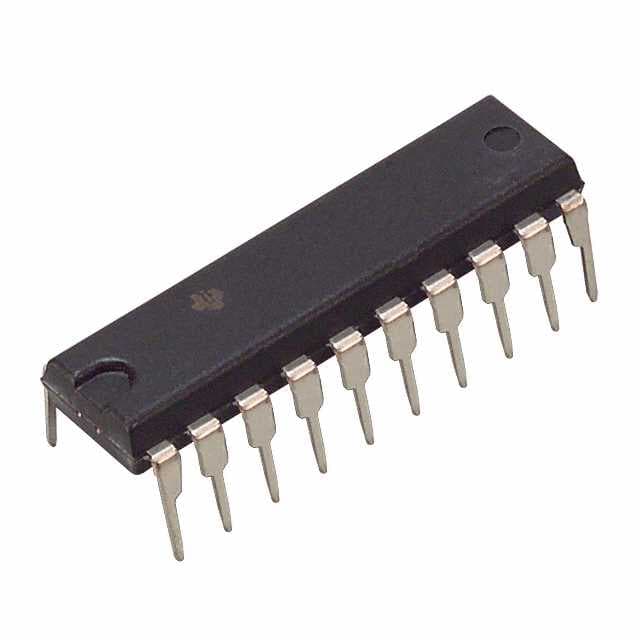Подробную информацию о продукте см. в характеристиках.

SN74LS688NG4
Product Overview
- Category: Integrated Circuit (IC)
- Use: Comparator
- Characteristics: High-speed, 8-bit magnitude comparator
- Package: DIP (Dual In-line Package)
- Essence: Logic circuitry for comparing two 8-bit binary numbers
- Packaging/Quantity: Available in tubes of 25 units or reels of 2000 units
Specifications
- Supply Voltage: 4.75V to 5.25V
- Operating Temperature Range: -40°C to +85°C
- Input Voltage Range: 0V to Vcc
- Output Voltage Range: 0V to Vcc
- Propagation Delay Time: 9ns (typical)
- Power Dissipation: 500mW (max)
Detailed Pin Configuration
The SN74LS688NG4 has a total of 20 pins, which are assigned as follows:
- A0: Input pin for the least significant bit (LSB) of the first 8-bit number.
- A1: Input pin for the second bit of the first 8-bit number.
- A2: Input pin for the third bit of the first 8-bit number.
- A3: Input pin for the fourth bit of the first 8-bit number.
- A4: Input pin for the fifth bit of the first 8-bit number.
- A5: Input pin for the sixth bit of the first 8-bit number.
- A6: Input pin for the seventh bit of the first 8-bit number.
- A7: Input pin for the most significant bit (MSB) of the first 8-bit number.
- B0: Input pin for the LSB of the second 8-bit number.
- B1: Input pin for the second bit of the second 8-bit number.
- B2: Input pin for the third bit of the second 8-bit number.
- B3: Input pin for the fourth bit of the second 8-bit number.
- B4: Input pin for the fifth bit of the second 8-bit number.
- B5: Input pin for the sixth bit of the second 8-bit number.
- B6: Input pin for the seventh bit of the second 8-bit number.
- B7: Input pin for the MSB of the second 8-bit number.
- G: Enable pin for the comparator.
- LT: Output pin indicating that A < B.
- EQ: Output pin indicating that A = B.
- GT: Output pin indicating that A > B.
Functional Features
- High-speed operation allows for quick comparison of two 8-bit numbers.
- Outputs indicate whether A < B, A = B, or A > B.
- Enable pin (G) allows for control over when the comparison takes place.
- Compatible with TTL (Transistor-Transistor Logic) and CMOS (Complementary Metal-Oxide-Semiconductor) logic families.
Advantages and Disadvantages
Advantages: - Fast propagation delay time enables rapid comparisons. - Versatile compatibility with different logic families. - Compact DIP package facilitates easy integration into circuit designs.
Disadvantages: - Limited to comparing 8-bit numbers. - Requires external control of the enable pin for proper functionality.
Working Principles
The SN74LS688NG4 operates by comparing the corresponding bits of two 8-bit binary numbers (A and B). The comparator determines whether A is less than, equal to, or greater than B. The enable pin (G) controls when the comparison occurs. The output pins (LT, EQ, GT) provide the result of the comparison.
Detailed Application Field Plans
The SN74LS688NG4 is commonly used in various applications, including: - Digital signal processing - Microprocessor-based systems - Arithmetic and logic units - Data sorting and searching algorithms - Control systems
Detailed and Complete Alternative Models
Some alternative models that offer similar functionality to the SN74LS688NG4 include: - 74HC688: High-speed CMOS version of the comparator. - CD4085: CMOS dual 4-bit magnitude comparator. - SN54/74LS85: 4-bit magnitude comparator with additional features.
These alternatives can be considered based on specific project requirements and compatibility with existing circuitry.
Word count: 497 words
Перечислите 10 распространенных вопросов и ответов, связанных с применением SN74LS688NG4 в технических решениях.
Sure! Here are 10 common questions and answers related to the application of SN74LS688NG4 in technical solutions:
Q: What is SN74LS688NG4? A: SN74LS688NG4 is a 8-bit magnitude comparator IC (integrated circuit) that compares two 8-bit binary numbers and determines their relationship.
Q: What is the purpose of SN74LS688NG4? A: The purpose of SN74LS688NG4 is to perform comparison operations in digital systems, such as determining equality, greater than, or less than relationships between two binary numbers.
Q: How does SN74LS688NG4 work? A: SN74LS688NG4 works by comparing each bit of the two input numbers and generating output signals based on the comparison results.
Q: What are the input and output pins of SN74LS688NG4? A: SN74LS688NG4 has eight input pins (A0-A7, B0-B7) for the two 8-bit binary numbers, and five output pins (EQ, GT, LT, A=B, A>B) for the comparison results.
Q: What is the voltage range supported by SN74LS688NG4? A: SN74LS688NG4 supports a voltage range of 4.75V to 5.25V.
Q: Can SN74LS688NG4 be used in both digital and analog circuits? A: No, SN74LS688NG4 is specifically designed for digital circuits and should not be used in analog applications.
Q: What is the maximum operating frequency of SN74LS688NG4? A: The maximum operating frequency of SN74LS688NG4 is typically around 33 MHz.
Q: Can SN74LS688NG4 be cascaded to compare larger binary numbers? A: Yes, multiple SN74LS688NG4 ICs can be cascaded together to compare larger binary numbers by connecting the output of one comparator to the input of another.
Q: Are there any special considerations for using SN74LS688NG4 in high-speed applications? A: Yes, it is important to consider signal propagation delays and setup/hold times when using SN74LS688NG4 in high-speed applications to ensure accurate comparison results.
Q: What are some common applications of SN74LS688NG4? A: SN74LS688NG4 is commonly used in digital systems for tasks such as arithmetic operations, data sorting, priority encoding, and control logic design.

